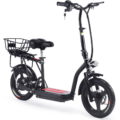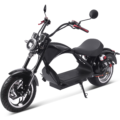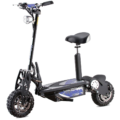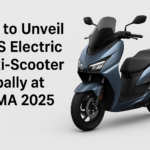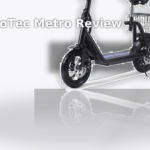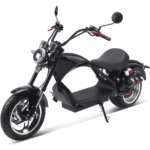- Home
- Scooters
- Electric Scooters
- MotoTec Knockout
MotoTec Knockout
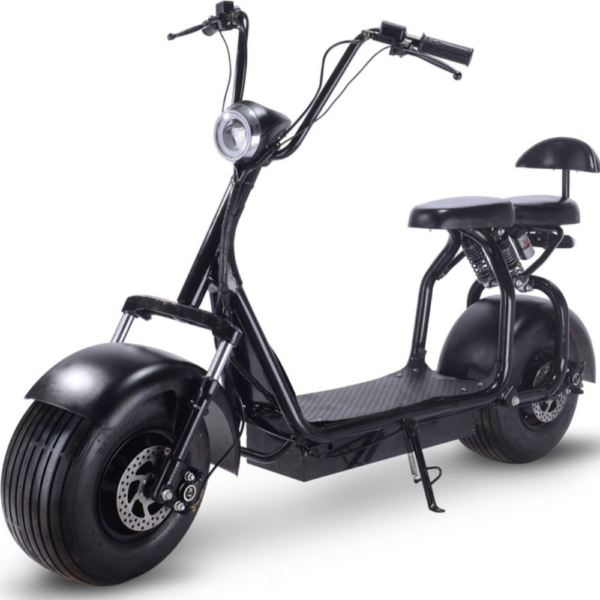

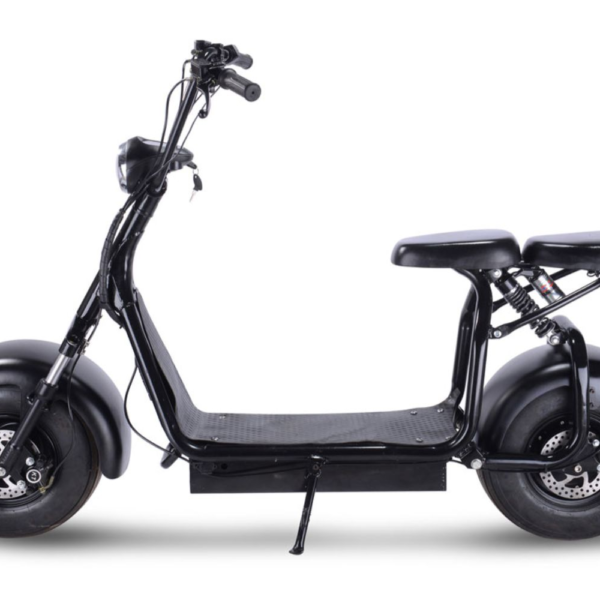
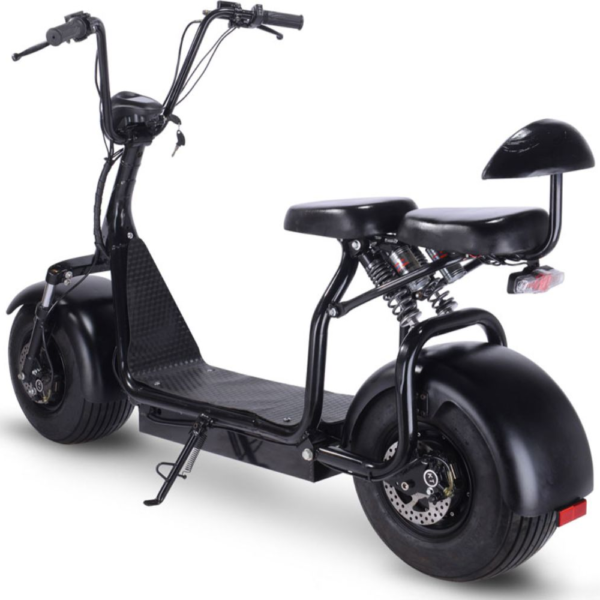
- Battery Range: 15–23 miles (24–37 km)
- Top Speed: 26 mph (42 km/h)
- Motor Power: 1000 W
- Weight Capacity: 450 lb (204.1 kg)
- Charging Time: ~4–8 h
- Scooter Weight: 165.0 lb (74.8 kg)
PROS
- Hydraulic disc brakes front & rear
- 225/55-8 fat tires for stability
- Front & rear shocks
- 3 selectable speed modes (10/18/26 mph)
- High 450 lb (204 kg) rider capacity
CONS
- Very heavy at 165 lb (74.8 kg)
- Lead-acid battery adds weight and slower charging
- IP rating not specified
- Range modest versus lithium models
Key Takeaways
- The MotoTec Knockout is a fat-tire, seated electric scooter designed for comfort and ease of use in urban environments.
- It features a 60 V lithium-ion battery, a 1000 W brushless rear hub motor, and three ride modes for different speed needs.
- With a top speed of 25 mph and a range of 15–20 miles, it’s ideal for short trips and errands.
- The scooter’s design focuses on a stable ride, with a simple control setup and dual hydraulic disc brakes for safety.
- It’s best suited for riders who value comfort and stability, but it’s not ideal for those needing a portable, foldable scooter.
Table of contents
- What Is the MotoTec Knockout?
- How the MotoTec Knockout Works
- Key Specifications
- Design & Build Quality
- Performance Fundamentals
- Battery, Range & Efficiency
- Ride Quality & Comfort
- Braking & Safety Features
- Portability & Daily Usability
- Maintenance & Care
- Weather & Seasonal Considerations
- MotoTec Knockout vs Alternatives
- Who the MotoTec Knockout Is (and Isn’t) For
- FAQs
- Glossary
- Final Notes on Specs Context
The MotoTec Knockout is a fat-tire, seated electric scooter for easy city rides and quick errands. It runs a 60-volt system, a quiet hub motor, and extra-wide tires that keep it steady at slow speeds. The setup favors comfort and simple controls. So new riders get comfy fast, and seasoned riders can just relax and cruise.
What Is the MotoTec Knockout?
The MotoTec Knockout is a low, steel-frame scooter with a bench seat and 225/55-8 tubeless tires. It looks like a mini cruiser, and it rides that way. You sit upright, rest your feet, twist the throttle, and go. A 60 V battery feeds a brushless rear hub. Stopping power comes from hydraulic discs front and rear. The cockpit stays simple, and the lights cover dusk and short night rides.
It doesn’t fold, and it isn’t light. So it’s not a classic carry-to-the-office commuter. It’s more of a ground-floor, roll-out-and-ride machine. Campus trips, park paths, grocery dashes, and weekend loops suit it well.
How the MotoTec Knockout Works
The powertrain is direct and quiet. You twist the throttle, the controller meters current from the 60 V pack, and the rear hub spins. There are no chains or belts. So noise stays low, and upkeep stays simple.
Braking feels clear and linear. Pull the right lever for the front and the left for the rear. Pressure builds fast, and the bite firms up after a short pull. So speed changes feel smooth, and hard stops track straight. On painted lines, keep the bike upright, and you’ll feel calm control.
Three ride modes shape throttle feel and cap speed. Pick the low mode for crowded paths. Then step to the mid mode for steady cruising. Open roads call for the top mode. The lights pull power from the main pack, and a key switch helps with basic security when you park.
Key Specifications
Here are the core specifications riders ask about first. Small details can vary by version, yet this list reflects the common setup.
General
- Model: MotoTec Knockout
- Type: Fat-tire, seated electric scooter
- Riding position: Upright on a padded bench
- Frame: Steel tube, fixed (non-folding)
Performance & Power
- Motor: 1000 W brushless rear hub
- Top speed: up to 25 mph (40 km/h) on level ground
- Drive: Rear-wheel direct hub
- Ride modes: 3 speed levels
- Hills: short 7–10% grades with a running start
Battery, Charging & Electrical
- Battery: 60 V lithium-ion, 12 Ah common trim (≈720 Wh); some runs 20 Ah (≈1200 Wh)
- Estimated range: about 15–20 mi (24–32 km) in steady, level cruising
- Controller: 60 V brushless controller
- Charger: 67.2 V output, ~2 A
- Charge time: ~4–6 hours for 12 Ah; longer for 20 Ah
- Lights: LED headlight, tail/brake light
- Display: Simple battery indicator
Build & Dimensions
- Suspension: Telescopic fork (front), spring shock (rear)
- Tires: 225/55-8 tubeless pneumatic, wide profile
- Brakes: Hydraulic discs front and rear
- Seat: Padded bench with upright ergonomics
- Overall size: compact seated layout for urban paths
- Folded dimensions: Not applicable (fixed frame)
Safety & Control
- Braking system: Dual hydraulic discs with easy modulation
- Handlebar controls: Throttle, mode selector, lights
- Audible alert: Electric horn
- Key switch: Yes
- Water protection: No published IP rating
Features & Extras
- Kickstand: Side stand
- Mirror mounts: Present on many units
- Cruise Control: Not supported
- Storage habits: Lock through the frame and store indoors
Warranty & Compliance
- Warranty: Limited manufacturer parts coverage
- Charger: Standard wall outlet
- Local use: Follow local scooter and path rules
Design & Build Quality
The frame is simple and tough. It sits low, and it feels solid over bumps. So balance at walking pace comes easy. Welds look sturdy, paint holds up well, and the hardware is easy to reach. The wiring looms along the frame in a clean way. You can trace the cables from the bars to the controller without guessing.
Those fat tires set the tone. They run at modest pressures, and they take the sting out of cracks and seams. The fork and rear spring smooth bigger hits like speed humps. The cockpit keeps your spine neutral and your arms relaxed. The bench spreads load better than a narrow saddle. Fit and finish land in a practical place. It’s not flashy, yet everything works like you want.
Performance Fundamentals
Throttle pickup is smooth right off the line. So creeping through tight areas feels controlled, not jerky. The mid mode hits a sweet spot for paths. Then the top mode helps on open stretches. Steering is slower than a stand-up scooter, which is the point here. The front end doesn’t twitch, and the bike tracks straight over rough pavement.
On grades near 7–10%, plan for a small speed dip. Build a bit of momentum, hold steady throttle, and let the hub pull. Short climbs feel fine. Long, steep climbs drain the pack faster and add heat. So pick rolling terrain when you can. The brakes are a strong suit. The rear lever helps with low-speed control, and the front firms up high-speed stops.
Battery, Range & Efficiency
The common pack is 60 V at 12 Ah, which is about 720 Wh. Some versions ship with a 20 Ah pack for around 1200 Wh. Range shifts with speed, weight, hills, wind, and temperature. On flat paths at a steady pace, you can reach the higher end. With frequent stops, grades, or cold air, expect the lower end.
Good habits help the pack last. After a ride, let the scooter sit at room temperature for a bit. Then charge in a cool, dry spot with clear airflow around the charger. For daily use, keep the state of charge near the middle. Aim for roughly 30–80% during the week. Top to 100% before a longer day, then ride soon. Store indoors and away from heat sources.
Ride Quality & Comfort
Comfort starts with those wide, air-filled tires. They spread load and cushion the deck. So cracks, seams, and cobbles feel like dull thumps, not sharp hits. The fork and rear spring soak bigger bumps. The seat supports your pelvis well, which helps on longer loops.
Steering feel stays calm. The handlebar post is short and stiff, so stem flex is minimal. Mid-corner tweaks feel precise. Turn-in is slower than narrow-tire scooters, and that’s fine. Tight slalom moves need a bit more bar input. Many riders like that planted, cruiser vibe on paths and side streets.
Braking & Safety Features
The dual hydraulic discs stop with confidence. Lever feel ramps fast, and the pads bite cleanly about halfway through the pull. Use both brakes, and shift your weight back in hard stops. On clean pavement, the wide tires help you hold a straight line.
Lighting is simple and does the job. The headlight works for dusk and slow rides at night in lit areas. The tail light brightens under braking, which helps drivers notice you. Add reflective gear for more pop. There’s no stated IP rating. So treat rain as a risk, slow down, and keep electronics dry. After wet rides, wipe things down and check the brakes.
Portability & Daily Usability
This scooter doesn’t fold. So plan a ground-floor corner, a garage spot, or a bike room. The side stand feels stable, and the key switch shuts the system down. For security, run a U-lock through the frame to a fixed object. Then add a disc lock if you park in public often.
Daily use feels simple. You step through, sit, and ride. The turning circle works for tight lots and narrow paths. Charging uses a standard wall outlet. Route the cable along the frame, and keep it tidy to avoid trips. In small homes, a mat under the parking spot keeps tire dust off the floor.
Maintenance & Care
Keep a short routine. It pays off with a quiet, tight ride.
Before each ride
- Check tire pressure with a gauge or a firm squeeze.
- Pull both brake levers and feel for solid resistance.
- Scan tires for cuts or stuck debris.
- Turn on the lights and confirm headlight and tail/brake function.
Weekly
- Inspect rotors and pad wear.
- Wipe dust from calipers, fork stanchions, and the rear spring.
- Recheck torque on bar, stem, and seat hardware.
- Spin wheels to look for rub or wobble.
Monthly
- If your rims are spoked, check tension and true.
- Look over the wiring loom for chafe spots and wrap with cloth tape where needed.
- Clean and lube the kickstand pivot.
Battery care
- Keep the daily charge near the middle bands when you can.
- Charge at room temperature.
- Avoid deep discharges.
- For breaks over two weeks, store near 40–60% state of charge.
Brake service
- If lever travel grows long, bleed the system and replace pads as needed.
- Clean rotors with isopropyl alcohol.
- Bed new pads with a set of gentle stops before hard ones.
With this rhythm, you’ll skip most surprises. Parts are basic, access is good, and the rear wheel drops without drama.
Weather & Seasonal Considerations
Temperature and moisture change both range and grip. Cold air cuts battery output, so range drops. Hot days can look okay for range in the moment, yet heat stresses cells. So park in shade on summer days, and never leave the scooter in a closed car.
Rain adds risk on paint, plates, and polished stone. Slow down, widen your gap, and steer with light hands. Brake earlier, and cross slick patches upright. Snow and ice don’t suit this scooter. The fat tires help at a crawl, yet stopping distance grows fast. After wet rides, dry the bike and let the pack return to room temp before charging.
MotoTec Knockout vs Alternatives
Think of classes and the choice gets clear. A stand-up commuter is light and easy to carry. A performance scooter sprints hard and eats long climbs. An off-road model brings more travel and knobby tires for dirt. The MotoTec Knockout sits between these. It wins on seated comfort, low-speed stability, and a calm steering feel. So it suits riders who want easy miles, not peak sprint numbers.
A tall-stem commuter folds, lifts, and tucks under a desk. The Knockout doesn’t. It weighs more, and it likes a ground-floor life. If you want a nimble, stand-up form factor with a folding stem, see the MotoTec Metro. It packs easier and fits small spaces. And if you want a playful off-pavement feel for short dirt paths, the MotoTec Free Ride brings a lighter stance and a different vibe. Then again, if you want a planted, seated ride on paths and side streets, the Knockout makes sense.
Who the MotoTec Knockout Is (and Isn’t) For
Great for
- Riders who like a seat and a stable stance
- Neighborhood errands, campus runs, and park loops
- Owners with ground-floor storage or a garage spot
- New riders who want calm steering and easy balance
Not ideal for
- Multi-modal commuters who carry up stairs
- Office riders who need to fold and stash under a desk
- Long, steep hills that demand high sustained power
- Rainy regions where a published IP rating is a must
FAQs
How fast is the MotoTec Knockout?
It reaches about 25 mph (40 km/h) on level ground in the top mode.
What range can I expect per charge?
Plan on roughly 15–20 miles (24–32 km) with steady cruising on flat paths.
Can I ride it in the rain?
You can, with care, yet there’s no published IP rating. So slow down and keep electronics dry.
Does it have Cruise Control?
No. Controls stay simple, and you hold the throttle to keep speed.
Is the MotoTec Knockout good for hills?
It handles short 7–10% grades with a running start. Long, steep hills drop speed and drain the pack faster.
Where can I read a MotoTec Knockout overview in one place?
You’re reading it now. This MotoTec Knockout overview covers the system, specifications, and care.
What tire pressure should I run?
Use the range printed on the 225/55-8 sidewall. Then nudge a bit for comfort or steering feel.
Glossary
- Ah (amp-hours): Battery capacity. More Ah holds more charge.
- Wh (watt-hours): Battery energy. Voltage times amp-hours.
- Brushless hub motor: Motor inside the wheel that spins the rim directly.
- Controller: Box that regulates power from the battery to the motor.
- Torque: Turning force that starts and drives the wheel.
- Regeneration (regen): Motor braking that feeds energy back. Not present here.
- Hydraulic disc brake: Fluid system that pushes pads on a rotor for strong stops.
- IP rating: Code for water and dust protection. Not published for this model.
- Stem flex: Bending at the handlebar post. Minimal on this frame.
- Pneumatic tire: Air-filled tire that cushions bumps.
- Tubeless: Tire seals to the rim without a tube.
- Throttle: Hand control that sets motor power.
- Speed mode: Preset that caps speed and shapes throttle feel.
- Voltage (V): Electrical potential that helps deliver power.
- Current (A): Flow of charge that produces heat at high levels.
- Watt (W): Unit of power used for motor rating.
Final Notes on Specs Context
These specifications define the Knockout’s character. The 60 V system, the 1000 W hub, and the 225/55-8 tires make a calm, seated cruiser. Dual hydraulic discs and a simple cockpit keep riding easy and low stress. For many riders, that blend just works for short daily trips.
Specifications
General
| Model The Model specifies the exact version or name of the scooter. It helps identify its unique design, features, and specifications within the manufacturer’s product line. Knowing the model makes it easier to compare options, find compatible accessories, or look up support information. | Knockout |
| Brand The Brand identifies the manufacturer or company that designs and produces the scooter. A trusted brand is a sign of quality, reliability, and good customer support. Well-known brands often have higher standards for safety, performance, and after-sales service, giving you more confidence in your purchase. | MotoTec |
| Release Date The Release Date indicates when the scooter model was officially launched on the market. This helps you know how current the design, technology, and features are. A newer release date often means updated components, improved performance, and the latest safety or smart features. | 18 November 2025 |
| Recommended Age Recommended Age indicates the minimum age range that the scooter is designed for, based on safety, size, and ease of use. Following the recommended age helps ensure that riders can handle the scooter’s speed, weight, and controls comfortably and safely. Always check local laws and use protective gear, especially for younger riders. | 16+ |
Performance & Power
| Motor Power (Wattage) What it means: The motor power, measured in watts (W), shows how strong the scooter’s electric motor is. Why it matters: Higher wattage usually means better acceleration, more torque, and improved performance on hills or rough terrain. For example, a 250W motor is good for flat city roads and light riders, while a 500W or 1000W motor provides more power for faster speeds or climbing steep inclines. | 1000 W rear hub motor |
| Top Speed The Top Speed indicates the maximum speed that the scooter can reach under optimal conditions. It’s usually measured on level ground with a fully charged battery and an average rider weight. A higher top speed allows you to travel longer distances faster, but always ensure you ride within legal speed limits and your personal comfort zone for safety. | 26 mph (42 km/h); 3 selectable limits (10/18/26 mph) |
| Battery Capacity Battery Capacity refers to the total amount of energy the scooter’s battery can store, usually measured in ampere-hours (Ah) or watt-hours (Wh). A higher battery capacity means you can ride longer distances on a single charge, reducing the need for frequent recharging. Keep in mind that actual range can vary depending on rider weight, terrain, speed, and weather conditions. | 60 V 12 Ah (≈720 Wh) — Sealed lead-acid (5×12 V 12 Ah) |
| Estimated Range per Charge The Estimated Range per Charge indicates the average distance the scooter can travel on a single full battery charge. This range is calculated under optimal conditions, such as flat terrain, moderate speed, and average rider weight. Real-world range may vary depending on riding style, terrain, weather, and load. A longer range means fewer recharges and greater freedom for longer trips. | 15–23 miles (24–37 km) |
| Hill Climb Ability Hill Climb Ability describes the maximum incline or slope that the scooter can handle while maintaining stable performance. It’s typically expressed as a percentage or in degrees. A higher hill climb rating means the scooter can tackle steeper hills without losing too much speed or power. Actual climbing performance may vary based on rider weight, battery charge, and terrain conditions. | Not specified |
| Drive System The Drive System refers to how power from the motor is delivered to the wheels. Electric scooters typically use either a hub motor (directly integrated into the wheel) or a chain/belt drive system. A high-quality drive system ensures smooth acceleration, efficient power transfer, and low maintenance. The choice of drive system affects performance, noise level, and overall ride experience. | Rear hub (RWD) |
Charging & Electrical
| Charging Time Charging Time indicates how long it takes to fully recharge the scooter’s battery from empty to 100% using the standard charger provided. Faster charging means less downtime and more time on the road. Actual charging time may vary slightly depending on battery capacity, charger output, and environmental conditions. | Approx. 4–8 hours |
| Battery Type Battery Type refers to the specific technology used in the scooter’s battery, which affects performance, lifespan, weight, and charging time. Most modern electric scooters use high-quality lithium-ion (Li-ion) batteries because they offer a good balance of energy density, durability, and low maintenance. A reliable battery type ensures consistent power delivery and longer riding ranges. | Sealed lead-acid pack |
| Removable Battery A Removable Battery means the battery pack can be easily detached from the scooter for convenient charging and replacement. This feature allows you to charge the battery separately, swap it with a spare for extended range, or securely store it indoors in extreme weather. Removable batteries add flexibility and make it easier to keep your scooter powered up wherever you are. | Non-removable internal battery (fixed pack) |
| Regenerative Braking Regenerative Braking is an energy-saving feature that converts some of the energy normally lost during braking back into battery power. When you slow down or brake, the motor works in reverse to generate electricity, which helps extend the scooter’s range and improves overall efficiency. This system also reduces wear on traditional brake components, leading to lower maintenance over time. | No |
| Lighting Lighting refers to the built-in front and rear lights that enhance visibility and safety when riding in low-light conditions or at night. Good lighting helps you see the road ahead and ensures that other road users can see you. Many scooters include LED headlights, taillights, and sometimes brake lights or side reflectors for added safety and compliance with local traffic regulations. | LED headlight; other lighting not specified |
Build & Dimensions
| Scooter Weight Scooter Weight refers to the total weight of the scooter when fully assembled, including the battery. This affects how easy it is to carry, lift, and store the scooter when not in use. A lighter scooter is more portable and convenient for commuting, especially if you need to carry it upstairs or onto public transport. Keep in mind that a sturdy frame and quality components may add to the weight but also contribute to better durability and ride stability. | 165.0 lb (74.8 kg) |
| Maximum Rider Weight Maximum Rider Weight indicates the highest rider weight that the scooter is designed to safely support while maintaining optimal performance and stability. Staying within this limit helps ensure reliable acceleration, braking, and climbing ability, and it protects the frame, suspension, and motor from excessive strain. Exceeding the recommended limit may reduce performance and increase wear on components. | 450 lb (204.1 kg) |
| Deck Size Deck Size refers to the dimensions of the scooter’s standing platform. A wider and longer deck provides more foot space, allowing you to stand comfortably and adjust your stance while riding. A well-sized deck improves balance and stability, especially on longer rides or at higher speeds. Compact decks, on the other hand, help keep the scooter lightweight and portable. | Low-slung chopper-style frame; double seat with backrest |
| Handlebar Height Handlebar Height refers to the distance from the deck to the handlebars, which affects your riding posture and comfort. An appropriate handlebar height helps you maintain good balance, reduces strain on your back and arms, and makes steering more comfortable. Some scooters have adjustable handlebars to fit riders of different heights, while others have a fixed height for a streamlined design. | Tilt adjustable |
| Folding Mechanism The Folding Mechanism describes how easily and securely the scooter can be folded for carrying and storage. A well-designed folding system lets you quickly collapse the scooter into a compact size, making it convenient to transport on public transit, store under a desk, or fit into a car trunk. Look for sturdy latches and safety locks to ensure the scooter stays firmly in place when folded or unfolded. | Non-folding frame |
| Dimensions Folded Dimensions indicate the size of the scooter when it’s fully folded. This measurement shows how much space the scooter will take up when stored or carried, making it easier to check if it will fit in your car trunk, under a desk, or in a closet. Compact folded dimensions are ideal for commuters who need to bring their scooter on public transport or store it in tight spaces. | Unfolded: 71.0 × 32.0 × 45.0 in (180.3 × 81.3 × 114.3 cm); Folded: Not specified |
| Material Material refers to the primary construction materials used for the scooter’s frame and key components. High-quality materials like aircraft-grade aluminum, reinforced steel, or durable composites provide strength, stability, and a lighter overall weight. A sturdy material ensures the scooter can handle daily wear and tear while maintaining safety and performance. | High-tensile steel |
Safety & Control
| Brake Type(s) Brake Type(s) describe the braking systems the scooter uses to help you slow down or stop safely. Common brake types include mechanical brakes (like drum or disc brakes), electronic brakes, and foot brakes. Many scooters combine multiple braking systems for added safety and shorter stopping distances. The type and quality of brakes affect your control, especially when riding at higher speeds or on slopes. | Hydraulic discs front & rear |
| Suspension Suspension refers to the system that absorbs shocks and vibrations while riding, providing a smoother and more comfortable ride over uneven or rough surfaces. Scooters may have front suspension, rear suspension, or dual suspension for better shock absorption and stability. Good suspension helps reduce rider fatigue and improves control, especially when riding on bumpy roads or off-road paths. | Front & rear shocks |
| Tire Type Tire Type refers to the kind of tires the scooter uses, which directly affects ride comfort, traction, and maintenance. Common types include solid (airless) tires, pneumatic (air-filled) tires, or hybrid options. Pneumatic tires offer better shock absorption and a smoother ride on rough surfaces, while solid tires are puncture-proof and require less upkeep. The right tire type helps ensure safe handling and a comfortable ride in different conditions. | 225/55-8 street tires |
| Tire Size Tire Size indicates the diameter and width of the scooter’s tires, which affect ride comfort, stability, and how well the scooter handles different terrains. Larger tires generally offer better shock absorption and a smoother ride over bumps and rough surfaces, while smaller tires keep the scooter lighter and more portable. Choosing the right tire size helps ensure a balance between agility and comfort. | 8-inch rims |
| Kickstand The Kickstand is a built-in stand that allows you to park your scooter upright when it’s not in use. A sturdy kickstand keeps the scooter stable and prevents it from tipping over, protecting it from scratches and damage. It also makes storing and accessing your scooter more convenient, whether you’re at home, work, or on the go. | Not specified |
| Water Resistance Rating Water Resistance Rating indicates how well the scooter is protected against water and moisture, usually shown as an IP (Ingress Protection) rating. This rating helps you understand whether the scooter can handle light rain, splashes, or wet roads without damage. While most scooters are not fully waterproof, a good water resistance rating adds peace of mind when riding in changing weather conditions. Always avoid deep puddles or submerging the scooter to protect its electrical components. | Not specified |
Features & Extras
| Display/Console The Display (or Console) shows important real-time information about your ride, helping you monitor your scooter’s status at a glance. Typical displays show speed, battery level, distance traveled, and riding mode. Some models also include additional features like Bluetooth connectivity, app integration, or backlighting for better visibility at night. A clear and easy-to-read display enhances safety and convenience on every trip. | Not specified |
| Ride Modes Ride Modes refer to the different speed and power settings you can choose to match your riding style or road conditions. Common modes include eco for maximum range and energy efficiency, standard for everyday balance, and sport or turbo for higher speed and stronger acceleration. Switching between ride modes allows you to customize performance, conserve battery, and ride safely in various environments. | 3 speed modes (10/18/26 mph) |
| Smart App Connectivity Smart App Connectivity lets you pair your scooter with a dedicated mobile app via Bluetooth. Using the app, you can monitor real-time ride stats like speed, battery level, and range, adjust settings such as ride modes or cruise control, lock the scooter for added security, and sometimes receive firmware updates. This feature adds convenience and allows you to personalize your riding experience right from your smartphone. | No app |
| Anti-Theft System The Anti-Theft System helps protect your scooter from unauthorized use or theft. This feature can include built-in alarms, electronic motor locks, GPS tracking, or remote locking through a mobile app. A good anti-theft system provides peace of mind when parking your scooter in public spaces, adding an extra layer of security to safeguard your investment. | Keyed ignition |
| Cruise Control Cruise Control allows you to maintain a steady speed without continuously holding the throttle. This feature makes longer rides more comfortable by reducing hand fatigue and providing a smoother, more relaxed riding experience — especially on flat, open roads or bike lanes. For safety, cruise control can usually be easily activated or deactivated while riding. | No |
| Accessories Included Accessories Included lists the additional items that come with the scooter to enhance your riding experience and convenience. Common accessories may include a charger, kickstand, bell, lights, phone holder, or carrying strap. These extras add value by making your scooter safer, easier to use, and ready to ride straight out of the box. | Not specified |
Warranty & Compliance
| Warranty Period The Warranty Period indicates how long the manufacturer guarantees the scooter against defects in materials and workmanship under normal use. A good warranty provides peace of mind, showing the brand’s confidence in its product quality. Always check what parts are covered, such as the frame, battery, and motor, and follow the maintenance guidelines to keep your warranty valid. | 30 days parts replacement |
| Certifications Certifications confirm that the scooter meets specific safety, quality, and environmental standards set by recognized organizations or regulatory bodies. Common certifications may include CE, RoHS, UL, or other local compliance marks, depending on your region. These certifications ensure that the scooter is manufactured to high standards and is safe and legal to use in your country. | Region-dependent |


